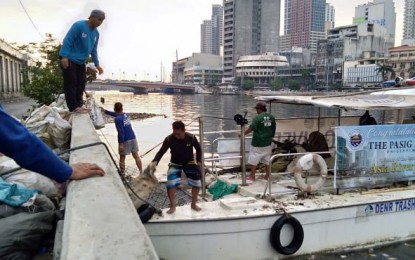
TOP PLASTIC POLLUTER. A photo taken on May 9, 2019 shows workers unloading sacks of garbage hauled from Pasig River which Rotterdam-based Ocean Cleanup identified as the top plastic-emitting river in the world. Malacañang on Thursday (June 10, 2021) said it is hoping that “with this badge of dishonor”, concerned government agencies would take radical steps to rehabilitate Pasig River. (File photo)
MANILA – Malacañang is saddened that Pasig River has been named as the world’s most polluting river when it comes to plastic waste.
“Nakakalungkot po iyan (That is saddening). That’s not something that we should be proud of,” Presidential Spokesperson Harry Roque said in a virtual presser on Thursday when sought for reaction. “Dati nga po, meron pa tayong commission just on Pasig River pero wala ring nangyari (There was a commission just on Pasig River before but nothing happened).”
Roque is reacting to the scientific study released by the Rotterdam-based Ocean Cleanup which identified Pasig River as the top plastic-emitting river in the world.
According to the study, the 27-kilometer Pasig River, which runs through Manila, accounts for 63,000 tons of plastic entering oceans from rivers per year.
Roque expressed optimism that the government would take “radical” steps to rehabilitate Pasig River.
“It is a test of our law enforcement capability. Pero ito po ay problema nga (But this is a problem) that has existed for many, many years now. Pero (But) I’m hoping that with this badge of dishonor, baka po maging radical din ang mga hakbang na gagawin ng ating gobyerno para malinis na once and for all ‘yung Pasig River na iyan (perhaps the government’s action to this would be radical to clean Pasig River once and for all),” Roque said.
Apart from Pasig River, around 18 other Philippine rivers are also included in the roster of the top 50 plastic waste carriers in the world.
The rivers included in the list are Tullahan River; Meycauayan River; Pampanga River; Limbanan River; Rio Grande de Mindanao River; Agno River; Agusan River; Parañaque River; Iloilo River; Imus River; Zapote River; Cagayan de Oro River; Davao River; Malaking Tubig River; Tambo, Pasay (Storm drain); Jalaur River; Cagayan River; and Hamulauon River.
The study also revealed that the Philippines is the biggest contributor to plastic pollution.
Around 466 out of 1,656 monitored rivers worldwide come from the Philippines, dumping more than 356,371 metric tons of plastic waste annually.
In 1999, the Pasig River Rehabilitation Commission (PRRC) was created through Executive Order (EO) 65 to rehabilitate the river to its historically pristine condition conducive to transport, recreation, and tourism.
Duterte on Nov. 8, 2019 inked EO 93 which abolishes the PRRC and transfer the commission’s functions to the Manila Bay Task Force, the Department of Environment and Natural Resources (DENR), the Department of Human Settlements and Urban Development (DHSUD), the Metro Manila Development Authority (MMDA), and the Department of Public Works and Highways (DPWH).
The Manila Bay Task Force is tasked to “update and take the lead” in the overall implementation of the Pasig River Rehabilitation Master Plan that will harness the Pasig River’s potential for transportation, recreation and tourism purposes while undertaking the rehabilitation and restoration of its marine life.
The DENR, on the other hand, is directed to ensure the enforcement of easements provided for in the Civil Code and other relevant laws, especially in estuaries and waterways that drain into the Pasig River.
Under EO 93, the DHSUD is tasked to lead the relocation of informal settlers and other unauthorized occupants along the banks of the Pasig River, while the MMDA and the DPWH are designated to ensure the dismantling and removal of all structures, constructions, and other encroachments established or built along Pasig River. (PNA)
